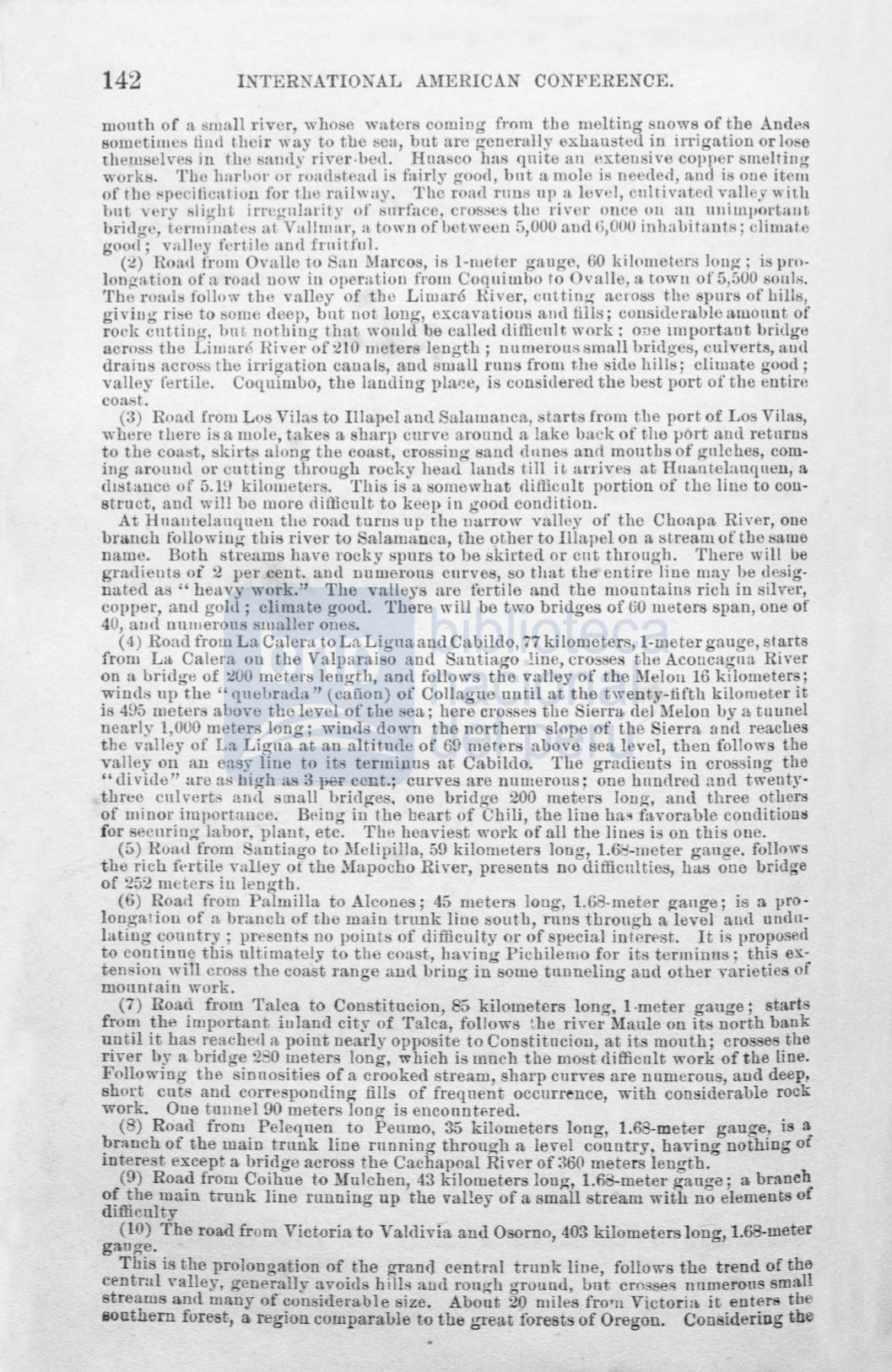

142
INTERNATIONAL AMERICAN CONFERENCE.
mouth of a small river, whose waters coming fTOtn tbe melting snows of the Andes
sometimes tind thcir way to the sea, but are gcnerally exhausted in irrigation orlose
themselves in the sa,ndy river-bed. Huasco has qnite an extensiva copper smelting
works. The hnrbor or roadstead i ' fairly good, bnt a mole is needed, and is oue item
of tbe ·pecitication for the railway. The roacl rnns up a lev•Jl, cnltivated valley wit.h
lmt verv litrht irrctruhuity of surface, crosses tbe river once ou an llllimportaut
bridge, tenufuates at""Val lu1ar,
a
town of betwecn
5,000
and
6,000
inhabitants; cliruat.e
good; v nlley fertile and frnitful.
(2)
Road from Ovalle toSan .Marcos, is 1-tüeter gauge, 60 kih,meters long; is pro–
longation of
a
road now in opemtiou from Coquimbo toOvalle, a towu of 5,500 sonh;.
Tbe roads follow tbe valley of tbe Limaré River, cnttiug across the spurs of bilis,
giviug rise to sorne deep, o'nt not long, excavatious aud filis; considerable amonut of
rock cnttiug-, bn t notbing tbat wonld be called difficnlt work:
o~e
importaot briuge
acro
s
the Liwaré River of210 meterslengtb; numeroussmall bridges, culverts,
ami
dTaiu · across the irrigation canals, and small runs from
t.heside hills; climate good;
valley fertile, Coquimbo, the landing pla0e, is considered the best port of tbe entire
coast.
(:3) Roacl froru Los Vilas to lllapel and Salamanca, starts from the port of Los Vilas,
v.-bere tbere is a mole, takes a sharp curve around
a
lake back of
t.heport anll retu-rns
to the coal:!t, ·kirts along the coast, crossing sand dnne!:! anrt moutbs of gulches, com–
ing arouud or cutting throngh rocky head. lands till iL arrives at Haantelauquen, a
chsta.nce
of
5.19
kilometers. This is
a
somewhat difficult portion of the line to cou–
struct, and will be more difficult to keep in good condition.
At Hnautelauquen the road turns up the uarrow valley of the Cboapa River, one
branch following this river to Salamanca, the other to Illapel on a stream of the same
name. Both streams have rocky spnrs to be skirted or cnt tbrongh . There will be
gradieuts of
2
per cent. and nurnerous curves, so that the entire line may be desig–
nated as" heavy wo1·k." The valleys are fertile and tbe mountains ricb in silver,
copper, anu golJ ; climate good. Tbere will be two bridges of 60 meters span, one of
40, aud nun1erous smaller ones.
(4)
Road from La Calera to LaLiguaandCabildo, 77kilometers, 1-meter gauge, starts
from La Calera on tbe Va.lparaiso and Santiago !ine, eros es tbe Acoucagna River
on
a
bridge of 200 meters lengtb, and follows the valley of the .Melon 16 kilometer ;
winds up tbe "qnebrad;l" (caüon) of Collague until at the twent.y-fifth kilometer it
is
495
meter above the level of the sea ; here crosses the Sierra dell\'lelon by
a
tuunel
nearly 1,000 meters long; winds clown tbe nortbern slope of the Sierra and reaches
tbe valley of La Ligna atan altitude of 69 meters above sea leve1, tben follows the
va-lley on an easy line to it terminus
at.
Cabildo. The gradients in crossing the
"divide" are
as
high as
3
p&
ccBt.; curves are nuruerous; one hnndred ancl tweuty–
three cul verte' and small bridg-es. one bridge 200 meters long, and tbree others
of minor importance. Being in the beart of Chili, tbe line
ha~
favorable
conditioo~:~
for secnring labor, plant, etc. The heaviest work of all the lines
i
on tbis one.
(5)
Road from antiago to Melipilla,
59
kilometers long, 1.61:;-meter gauge. follows
the rich fertile valley of the Mapocbo River, presents no difficulties, has oue bridge
of
252
meters in lengtb.
(6) Roafl from Palmilla to Aleones;
45
meters long, 1.68-meter gauge; is
a
pro–
lon_"'arion of
a.
branch of tbe main trunk 1ine south, rnns throngh a le\
7
el and uudu–
hmng country ; pre ents no points of difficulty or of specia1 intert>st.
It
is proposed
to continne this ultiruately to tlle coast, having Pichilemo for its termim1s; thi ex–
tension _will ero s the coast range and bring in sorne tnnneling and other varieties of
mountaJn work.
(7) Road from Talca to Constitucion, 85 kilometers long, 1-meter gauge; starts
from the important iuland
city
of Talca, follows
~be
river Maule on its north bank
u_ntil it has reached
a.
point nearly opposite to Constitncion, at its mouth; croases the
nver
by
a bridge
280
meters long, wbich is mnch the most difficult work of tbe line.
Following the sinuosities of a crooked stream, sharp curves are nnmcrons, ancl deep,
short
cut~
and corre ponding fills of frequent occurrence, with considerable rock
work. One tuunel90 meters long is enconntered.
(8) Road from Pelequen to Penmo. 35 kilometers long, 1.68-meter gauge, is a
~ranch
of the main trnnk line rnnning through
a
leve! country, ha.ving nothing of
mtere t except a bridge across tbe Cacbapoal Ri
ver
of
360
meters lengtb.
(9) Road from Coihue to Mulchen, 43 kilometers long, 1.60-meter gan(Ye; a branch
of the main trunk line running up the valley of a small stream with
n~
elements of
difficnlty
(10) Tbe road from Victoriato Valclivia and Osorno, 403 kilometers long, 1.68-meter
ga.uge.
This is the prolongation of the granel central truu k line, follows the trend of the
central
~alley,
generally avoid hil1s and rongb grouud, bnt ero ses numerons small
strearns and many of considerable ' ize. Abont 20 miles fro•n Victoria it enters tb
southern forest, a region comparable to tbe gr at forests of Oregon. Con
ideri.Dgthe
















